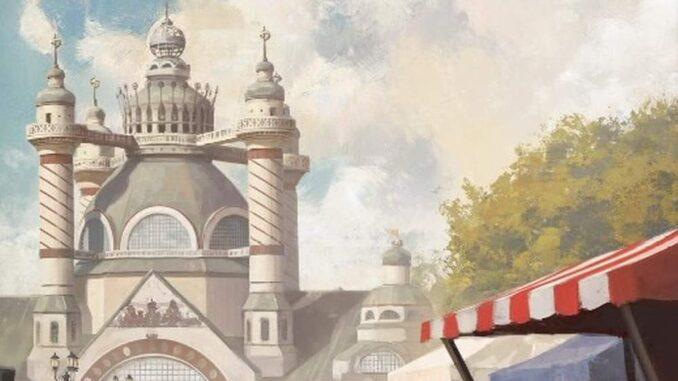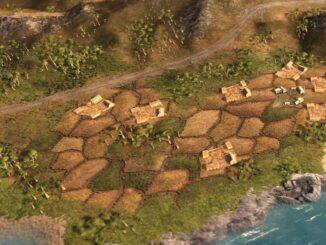
Trade Goods
Fundamentally, a unit of goods represent a quantity of a certain type of natural resource, manufactured good or intangible service and come attached with a price tag. This price varies both in base (a single unit of tanks is pricier than a single unit of fabric) and in actual market value, as the prices of goods change depending on supply and demand. The manufacturing of goods (by pops in buildings) is how the vast majority of the wealth in Victoria 3 is created.
Trade goods in the French market.

Goods Categories
There are four broad categories of goods:
- Staple goods are everyday goods that pops need to live, such as food to eat, wood to heat their homes, and clothes to wear. Staple goods tend to be purchased in vast quantities by poor and middle class pops, with richer pops generally avoid them in favor of their luxury variants.
- Luxury goods are the things that pops do not necessarily need but definitely want, such as fine foods, luxury drinks like tea and coffee, or fine clothes made from Chinese silk. Luxuries tend to be more profitable to produce than staple goods, but depend on having a customer base with money — a poor factory worker isn’t going to be buying a whole lot of mahogany cabinets.
- Industrial goods are goods such as iron, coal, rubber and lead whose main purpose is often to be converted into other, more profitable goods. Securing a steady supply of vital Industrial goods is crucial to industrialization and growing the GDP of the country.
- Military goods are goods such as small arms, ammunition and warships that are used by military buildings to arm and supply the armies and navies of the 19th century nations. The more technologically advanced the army or navy, the more complex and expensive military goods they will need.
Of those, staple and luxury goods are mainly consumed by pops, while industrial and military goods are mainly consumed by buildings. That said, there are no hard rules here — buildings may end up using luxury goods while pops may chose to purchase industrial goods if (when and where) it makes sense for them to do so.
Goods Types
Staple Goods
| Good | Base cost | Traded quantity | Prestige factor | Convoy cost multiplier | Consumption tax cost |
| Clothes | 30 | 15 | 4 | 0.5 | 300 |
| Electricity | 30 | No | 5 | No | 200 |
| Fabric | 20 | 20 | 3 | 0.25 | 300 |
| Fish | 20 | 20 | 3 | 0.25 | 300 |
| Furniture | 30 | 15 | 4 | 0.5 | 300 |
| Grain | 20 | 20 | 3 | 0.25 | 500 |
| Groceries | 30 | 15 | 4 | 0.5 | 300 |
| Paper | 30 | 15 | 4 | 0.5 | 200 |
| Services | 30 | No | 3 | No | 200 |
| Transportation | 30 | No | 4 | No | 200 |
| Wood | 20 | 20 | 3 | 0.25 | 300 |
Luxury Goods
| Good | Base cost | Traded quantity | Prestige factor | Convoy cost multiplier | Obsession chance |
| Automobiles | 100 | 8 | 10 | 1 | 1 |
| Coffee | 50 | 1 | 4 | 0.75 | 1.5 |
| Fine art | 200 | 5 | 15 | 1 | 1 |
| Fruit | 30 | 15 | 4 | 0.75 | 1 |
| Gold | 100 | No | 5 | 1 | |
| Liquor | 30 | 15 | 4 | 0.75 | 2 |
| Luxury clothes | 60 | 1 | 10 | 0.75 | 1 |
| Luxury furniture | 60 | 1 | 10 | 0.75 | 1 |
| Meat | 30 | 15 | 4 | 0.75 | 1 |
| Opium | 50 | 1 | 4 | 0.75 | 2 |
| Porcelain | 70 | 1 | 5 | 0.75 | 1 |
| Radios | 80 | 1 | 10 | 1 | 1 |
| Sugar | 30 | 15 | 4 | 0.75 | 1.5 |
| Tea | 50 | 1 | 4 | 0.75 | 1.5 |
| Telephones | 70 | 1 | 10 | 1 | 1 |
| Tobacco | 40 | 1 | 4 | 0.75 | 2 |
| Wine | 50 | 1 | 5 | 0.75 | 2 |
Industrial Goods
| Good | Base cost | Traded quantity | Prestige factor | Convoy cost multiplier |
| Clippers | 60 | 7 | 5 | 0.25 |
| Coal | 30 | 15 | 5 | 0.75 |
| Dye | 40 | 1 | 5 | 1 |
| Engines | 60 | 8 | 10 | 2 |
| Explosives | 50 | 8 | 10 | 1.5 |
| Fertilizer | 30 | 15 | 5 | 1 |
| Glass | 40 | 1 | 5 | 1 |
| Hardwood | 40 | 1 | 5 | 1 |
| Iron | 40 | 1 | 5 | 1 |
| Lead | 40 | 1 | 5 | 1 |
| Oil | 40 | 1 | 5 | 1 |
| Rubber | 40 | 1 | 5 | 1 |
| Silk | 40 | 1 | 5 | 1 |
| Steamers | 70 | 7 | 5 | 0.25 |
| Steel | 50 | 1 | 5 | 1 |
| Sulfur | 50 | 1 | 5 | 1 |
| Tools | 40 | 1 | 5 | 1 |
Military Goods
| Good | Base cost | Traded quantity | Prestige factor | Convoy cost multiplier |
| Aeroplanes | 80 | 6 | 10 | 2 |
| Ammunition | 50 | 1 | 5 | 1 |
| Artillery | 70 | 7 | 5 | 1.5 |
| Ironclads | 80 | 5 | 10 | 0.5 |
| Man-o-Wars | 70 | 5 | 5 | 0.5 |
| Small arms | 60 | 1 | 5 | 1 |
| Tanks | 80 | 6 | 10 | 2 |





Be the first to comment